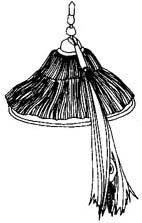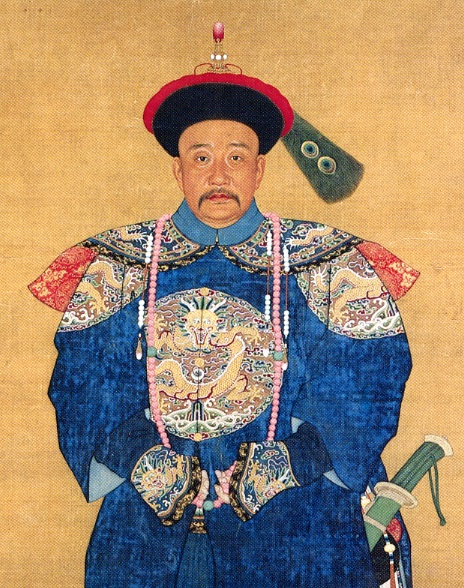Hat buttons (dingdai 頂戴, also written 頂帶) and peacock feathers (kongqueling 孔雀翎, hualing 花翎, in Manchu tojin funggala or tojin i funggala) were symbols of distinction as parts of the costume of Qing-period 清 (1644-1911) officials.
While the former signalized the rank of an official, the latter were bestowed to persons – state officials or non-officials – to honour merits achieved. Yet the emperor could also bestow a honorific hat button to express his gratitude. Hat buttons, and peacock feathers as well, lost their high symbolic character after the Daoguang reign-period 道光 (1821-1850), and both could even be purchased by donations to the state (see contributions).
A less prestigious expression of merit was the "blue (yet in fact rather blackish) plume" (lanling 藍翎, lamun funggala), a crow (?) or pheasant (he 鶡) feather granted to officials below rank 6. It was a regular hat decoration of the imperial guards (shiwei 侍衛) and the members of the imperial procession guard (luanyiwei 鑾儀衛). The younger troops in the imperial guard were therefore called lanling shiwei 藍翎侍衛 "blue-plume guardsmen". It might be that this type of feather was not naturally blue, but was died, and was therefore known as ranlan ling 染藍翎. This decoration, too, was purchasable, at a price of 4,000 tael, as in 1859.
There were two types of ceremonial hats (limao 禮帽, damao 大帽) for state officials, namely "warm hats" (nuanmao 暖帽) for winter, and "cold hats" (liangmao 涼帽, also called weilian 幃璉) for summer. The latter were were conical (similar to traditional bamboo hats, limao 笠帽) with a cone-shaped brim and were made of leather covered by a netting of crude fibres (tengsi 藤絲, yucao 玉草), and adorned with silken parts (luosha 羅紗). The winter hat was characterized by a wide brim (yanbian 檐邊, maoyan 帽檐, maobian 帽邊) that was reversed to stand up, and was thus more decorative than protective. The materials were leather, felt (nizi 呢子) and various types of silk (chouduan 綢緞) or other textiles like flannel (rongbu 絨布). Most winter hats were black. Both types of hat were adorned by a button (dingzhu 頂珠, dingdai) attached to the top. From this point, a large number of thin tassels (maowei 帽緯, maoying 帽纓) were hanging down to all sides. In case of the winter hat, the lower parts of the tassels were hidden behind the brim.
 |
 |
Source: Zhang (2002), 360. |
Apart from being divided according to the seasons, there were hats used during regular court ceremonies (chaoguan 朝冠) as part of the regular dress (changfu 常服), such belong to the dress for "auspicious" ceremonies (jifu 吉服, see Five Rites), and hats used during tours outside the residence (xingguan 行冠).
The system of hat buttons was as follows:
| rank | stone/material | ||
|---|---|---|---|
| 1 | 紅寶石 純紅頂 亮紅頂 |
hong baoshi chunhong ding lianghong ding |
ruby |
| 1b-2b | 珊瑚頂 鏤花珊瑚 雜紅頂 鎳紅頂 |
shanhu ding louhua shanhu zadong ding niehong ding |
red coral |
| 3a-4a | 藍寶石 亮藍頂 |
lan baoshi lianglan ding |
sapphire |
| 4b | 青金石 暗藍頂 鎳藍頂 |
qingjin shi anlan ding nielan ding |
azure-coloured stone |
| 5a | 水晶頂 亮白頂 |
shuijing ding liangbai ding |
crystal |
| 5b-6a | 白玉頂 硨磲頂 白瓷頂 |
baiyu ding chequ ding baici ding |
adularia, flour-spar |
| 6b-7b | 素金頂 金頂 |
sujin ding jinding |
gold |
| 8 | 陰文鏤花金頂 | yinwen louhua jin ding | gold with intaglio decoration |
| 9 | 陽文鏤花金頂 鏤銀頂 |
yangwen louhua jin ding louyin ding |
decorated silver or gold with cameo decoration |
Gold and silver hat decorations were also worn by graduates of the state examinations and students in the National University (taixue 太學): gold for metropolitan graduates (jinshi 進士), provincial graduates (juren 舉人), and "tribute students" (gongsheng 貢生 - gold), and silver for lower government students (shengyuan 生員) and students in the Directorate of Eduation (jiansheng 監生).
| 1-2 | red |
| 3-4 | blue |
| 5-6 | white |
| 7-9 | golden |
Peacock feathers were fixed to a stable base and attached to the top of the conical hat with the help of a tube (lingguan 翎管) of white (baiyu 白玉, military) or green jade (feicui 翡翠, civilian). It stood to the back of the person, slighly hanging down. In fact, the tubes were also made of other stones, porcelain, or just brass. Apart from normal peacock feathers with one "eye" (danyan kongqueling 單眼孔雀翎), there were very rare one with two eyes, the second, somewhat smaller, found below the terminal one (shuangyan kongqueling 雙眼孔雀翎, juwe yasa-i tojin funggala). On very rare occasions, three-eyed peacock feathers (sanyan kongqueling 三眼孔雀翎) were bestowed. There were also low-class peacock feathers without an eye. Some authors say non-eyed peacock feathers were identical to the blue plume (lanling).
Princes and the husbands of princesses (gurun i efu, Ch. gulun efu 固倫額附), i.e. noblemen of the first six degrees, were allowed to wear a three-eyed peacock feather, princes of the blood of a degree lower than six, as well as bearers of titles of nobility, were entitled to wear a two-eyed peacock feather unconditionally and just because of their rank (xiangdai 享戴), and some officials of rank higher than 5, namely Grand Ministers of the central government (nei dachen 內大臣), and the commanders of the Vanguard Brigade (qianfengying 前鋒營) and the Guards Brigade (hujunying 護軍營, all of which were by birth members of the three highest Banners), were entitled to wear a simple peacock feather. All others could only obtain a peacock feather by imperial grace and because of outstanding achievements in office.
The ranks of officials were also distinguished by plaques of embroidery (buzi 補子, bufu 補服) attached to the breast and back of the official robe. Each rank had a different motif.
| rank | civilian | military | ||
|---|---|---|---|---|
| 1 | 仙鶴 xianhe | white crane | 麒麟 qilin | unicorn |
| 2 | 錦雞 jinji | golden pheasant | 獅子 shizi | lion |
| 3 | 孔雀 kongque | peacock | 豹 bao | leopard |
| 4 | 雲雁 yunyan | wild goose | 虎 hu | tiger |
| 5 | 白鷴 baixian | silver pheasant | 熊 xiong | black bear |
| 6 | 鷺鷥 lusi | egret | 羆 pi | spotted bear |
| 7 | 鴛鴦 yuanyang, 鸂鶒 xichi |
Mandarin duck | 彪 biao | tiger-cat |
| 8 | 鵪鶉 anchun | quail | 海馬 haima | "sea horse" |
| 9 | 練雀 lianque | white-tailed jay | 犀牛 xiniu | rhinoceros |
| 黃鸝 huangli | oriole | -- | -- | |
The use of such embroidered plaques as a distinction for the ranks of civilian and military offices was introduced by Empress Wu Zetian 武則天 (ruler 690-704) during the Tang period 唐 (618-907). Civilian officials wore the motif of a bird, and military ones that of a fierce animal. After Wu Zetian's downfall, the insignia were abolished and were only revived by the Ming dynasty 明 (1368-1644). The square motifs were 40 cm-wide and embroidered with golden yarn on a red background of silk fabric. During the Qing period the motif on the front was divided into two parts, separately stitched on the two halves (duijin 對襟) of the breast flaps. The image was either square or round and embroidered with yarn of several colours on a dark background. Unlike the Ming, the Qing preferred a borderline (biankuang 邊框) around the image.
In addition to these distinctions, officials of the first five ranks (in case of military officials those of rank 4 and higher) wore a long necklace of pearls (chaozhu 朝珠). The necklace had three short branches of strings of blue stones hanging down at the front (called jinian 紀念, "for remembering"), and one at the back (called beiyun 背雲 "back cloud"). The main string, hanging on the breast, was called fotou 佛頭 "Buddha head". The necklace originated in the Buddhist "rosary" with 108 pearls, of which four beads (fenzhu 分珠) were larger and divided the string into four sections. The emperor used necklaces of "eastern pearls" grown in the River Sunggari (dongzhu 東珠, Manchu tana) or "genuine pearls" (zhenzhu 珍珠), the Empress and Empress Dowager one string of eastern pearls and two made of corals, and all other persons were free to use all other materials, like coral, agate, ivory, jade, amber, agarwood (chenxiang 沉香) or other precious stones.
 |
Fuheng (d. 1770), one of the highest men in the Qing hierarchy. As a brother-in-law of the Qianlong Emperor 乾隆帝 (r. 1736-1796) he was allowed to wear the imperial breast motif (buzi) with the image of a dragon. The central seam dividing the plaque can be seen. Fuheng was entitled to wear a two-eyed peacock feather (shuangyan kongqueling), here attached to the winter hat (nuanmao), which is decorated with a ruby hat button (dingdai). His necklace (chaozhu) is apparently made of corals. The interstitial beads in turquois colour are also visible. The huge-size collar was called piling 披領, the overlong sleeves were known as "horse-hoof sleeves" (matixiu 馬蹄袖). Source: Public domain. |
The ceremonial rules for peacock feathers were promulgated in 1661, but as early as 1623, Nurhaci (r. 1616-1626) already created a system for ceremonial hats at the Jurchen court, with a golden hat button. In the same year he ordered to wear hats of simple materials, while silk was reserved to female robes. Hung Taiji (r. 1626-1643) thereafter standardized the system of court and military robes and introduced the hat buttons signifying the official rank. These rules were finalized during the Qianlong reign-period 乾隆 (1736-1796).